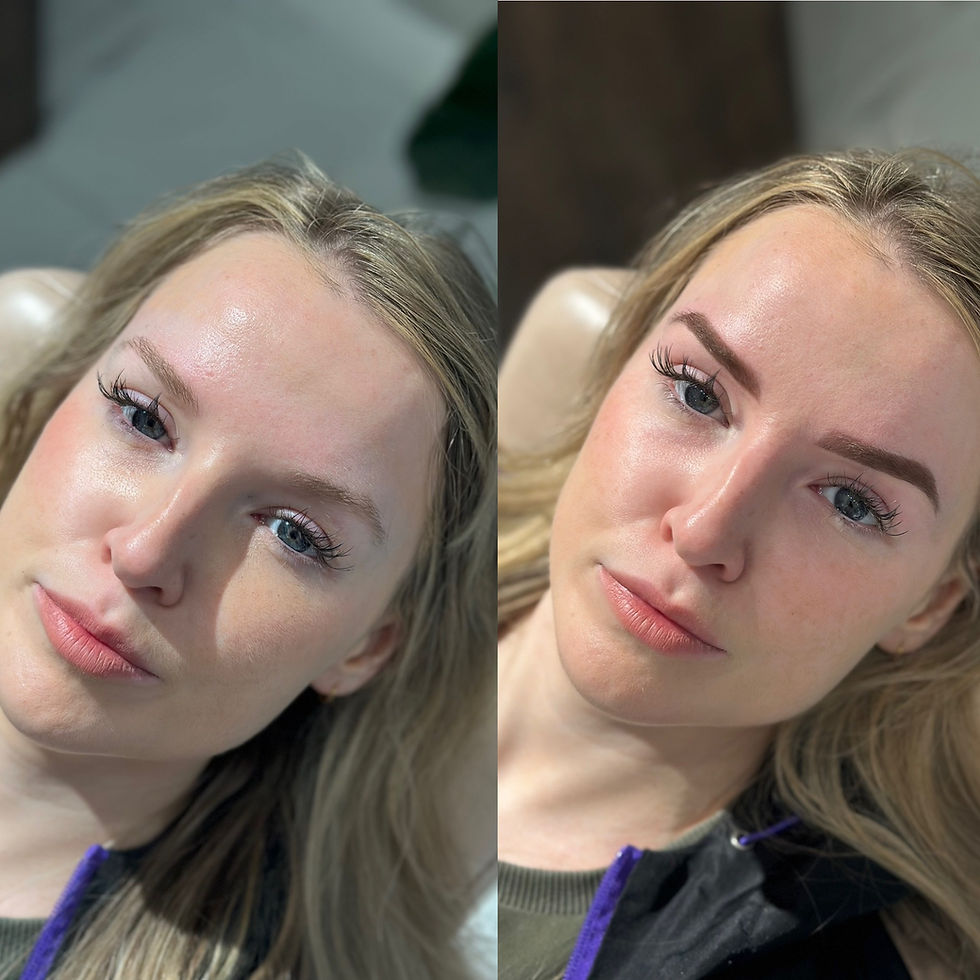When the Skin Fights Back: The Hidden Science of Healing After Cosmetic Tattooing
- Ira Bale

- 1 hour ago
- 4 min read
By Ira Bale – Cosmetic Tattoo Artist, Melbourne, South Yarra and Toorak Village
Because great results depend on more than the artist. They depend on your biology.
1. The Part Nobody Talks About: Your Skin Has Its Own Agenda
Most people think cosmetic tattooing is all about technique. The outline, the pigment choice, the mapping. But once you walk out of the salon, another artist takes over. The skin.
Your skin decides how pigment settles, how colour shifts, how long the tattoo lasts, and whether the result heals clean or chaotic. It is not passive. It is intelligent, reactive, and protective.
At Ira Bale Brows South Yarra and Toorak Village, I tell clients that your healed result is not a snapshot of the treatment. It is a collaboration between my hand and your biology.

2. The Skin’s Defense System and Why It Sometimes Misbehaves
Cosmetic tattooing creates controlled micro injury. It is safe, precise, and intentional, but it still triggers an immune response. Your body sees pigment as a visitor. Not an invader, not a threat, simply something to monitor.
Three major processes decide the fate of your tattoo:
Inflammation Swelling begins within minutes. This is not a complication. It is your capillaries carrying immune cells to clean the area.The problem begins when inflammation is excessive, usually because of poor aftercare, aggressive exercise, or heat exposure.
Macrophage Activity These cells are the skin’s security guards. They surround pigment particles to keep them in place. Good artists rely on this process. Poor artists trigger it too aggressively, leading to pigment clumping or migration.
Fibroblast Repair These cells rebuild collagen during the healing stage. They determine whether the skin heals smooth or slightly textured. This is why correct depth is everything. Too deep forces fibroblasts to build scar tissue around the pigment.
Your skin is both your protector and your critic. It decides what stays and what fades.
3. Why Some Clients Heal Perfectly and Others Heal Patchy
Healing patterns vary for reasons most clients never consider. A few examples:
• Hormones influence inflammation levels, blood flow, and pigment retention.
• pH changes affect how undertones appear during the healing stage.
• Medications such as antihistamines, antidepressants, and acne treatments alter absorption and sensitivity.
• Skin thickness varies with age and ethnicity.
• Lifestyle plays a major role. Regular exercise, hot showers, saunas, and even stress all alter healing.
This is why no two clients ever heal the same. It is not about the tattoo being “wrong.” It is about biology being individual.
4. The Myth of Perfect Healed Results
Beauty influencers often show healed results that look untouched, poreless, and uniform.Real skin does not heal like that. Real skin heals with micro texture, soft fading at the edges, and slight variation. Those are the signs of a natural, skin compatible tattoo.
If a tattoo looks painted once healed, it is too saturated. If it looks harsh, it was implanted too deep. If it looks flat, the pigment lacked undertone balance.
Healed realism is the real luxury.
5. When the Skin Rejects Pigment and Why It Happens
Rejection does not mean the tattoo failed. It means the skin prioritised safety. This can happen for three reasons:
The immune system is overactive Autoimmune conditions can cause pigment loss or uneven retention.
The surface was compromised Over exfoliation, chemical peels, or recent lasers weaken the barrier.
The skin was too hot or too active during healing Sweat and heat force pigment out during the first 72 hours.
When this happens, I always reassure clients. Correction is simple when pigment is implanted correctly. Damage happens only when the first treatment was done too deep or too aggressively.
6. Why Aftercare Is More Important Than Most People Realise
Even the best work can be ruined by poor aftercare. Here is why:
• Sweat pushes pigment out of fresh channels.
• Water exposure softens healing tissue and dilutes pigment.
• Sleeping on your face shifts pigment and changes shape.
• Touching the area introduces bacteria.
At both salons, we give clients a clear, science backed aftercare plan because the first seven days decide the next twelve months.
7. When the Skin Loves the Tattoo: The Ideal Healing Pattern
The best healing outcome usually looks like this:
• Day 1: Brows look crisp and slightly darker
• Day 2 to 4: Colour deepens as oxidation begins
• Day 5 to 7: Micro flaking begins, pigment softens
• Week 2: Colour looks lighter and slightly muted
• Week 4 to 6: Colour returns, balanced and natural
This pattern shows a healthy immune response and correct pigment depth. It is the result of skill, mapping, pigment science, and the client’s dedication to aftercare.
8. The Artist’s Responsibility and the Skin’s Response
A good artist controls technique. A great artist understands how skin responds to that technique.
Every decision I make, from needle choice to pigment composition, is designed not only for the initial result but for the healing journey that follows.Nothing is accidental. Nothing is rushed. Nothing is left to chance.
Healing is predictable only when artistry is intentional.
9. Why This Matters in Melbourne’s Beauty Landscape
Melbourne clients are informed and observant. They want healed results that look refined in natural daylight, not filtered perfection. That standard pushes every ethical artist to take skin science seriously.
At Ira Bale Brows, this is not an optional philosophy. It is the foundation of our work.
Because cosmetic tattooing is not just what I do to the skin. It is what the skin decides to do next. Understanding that difference is what separates safe, elegant results from everything else.
For healing that respects your biology and results that age with dignity, visit Ira Bale Brows South Yarra or Toorak Village. Precision begins with the treatment and continues with the skin that carries it.



Comments